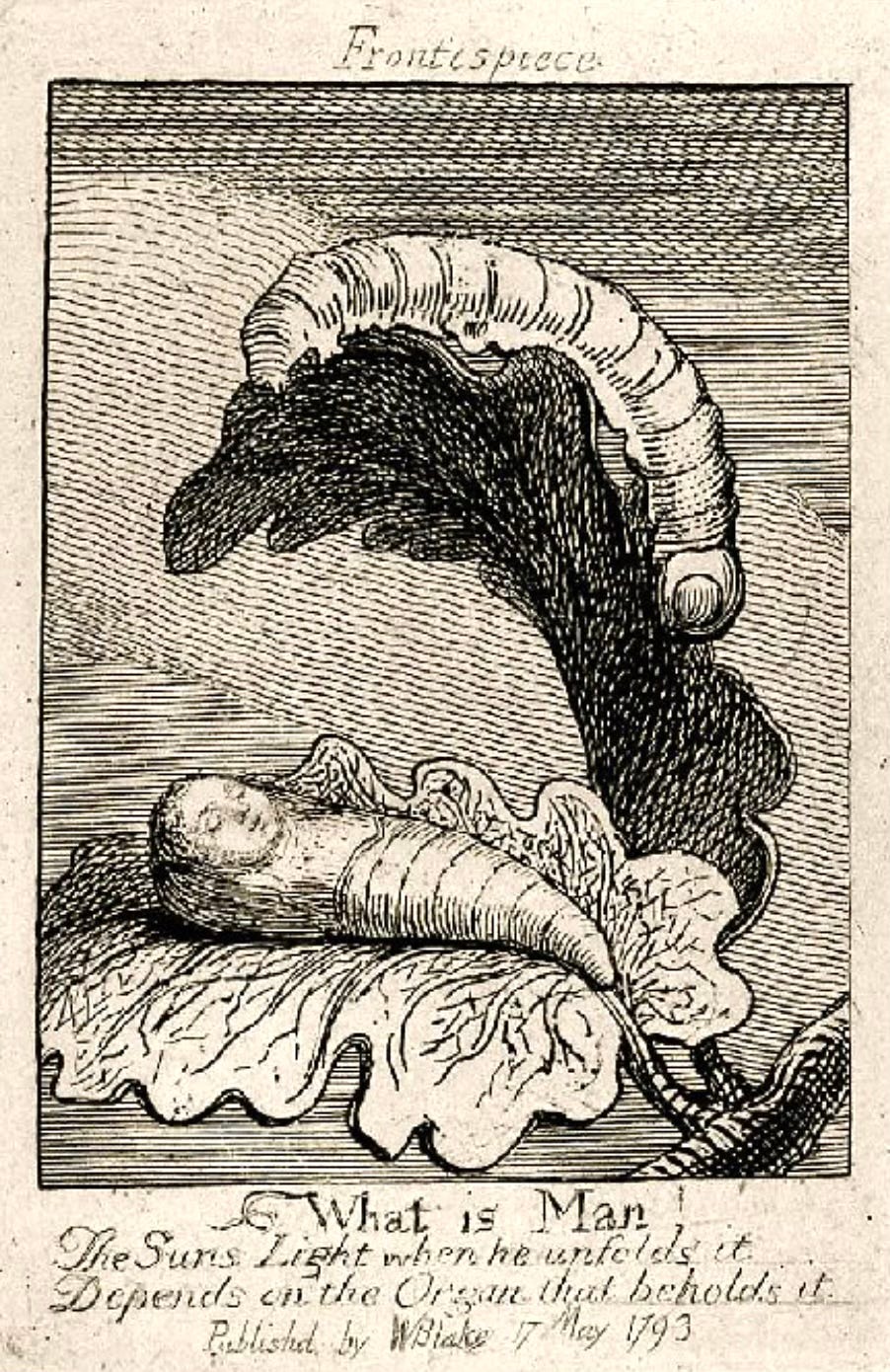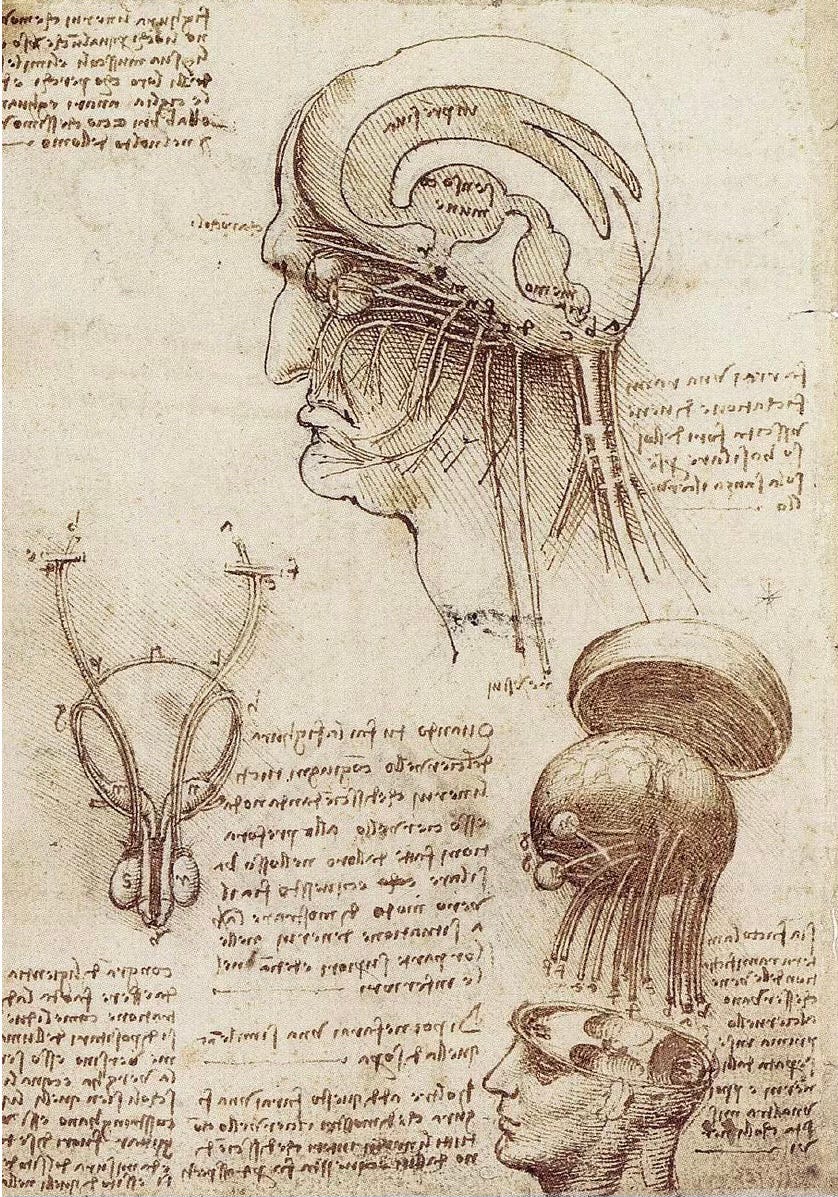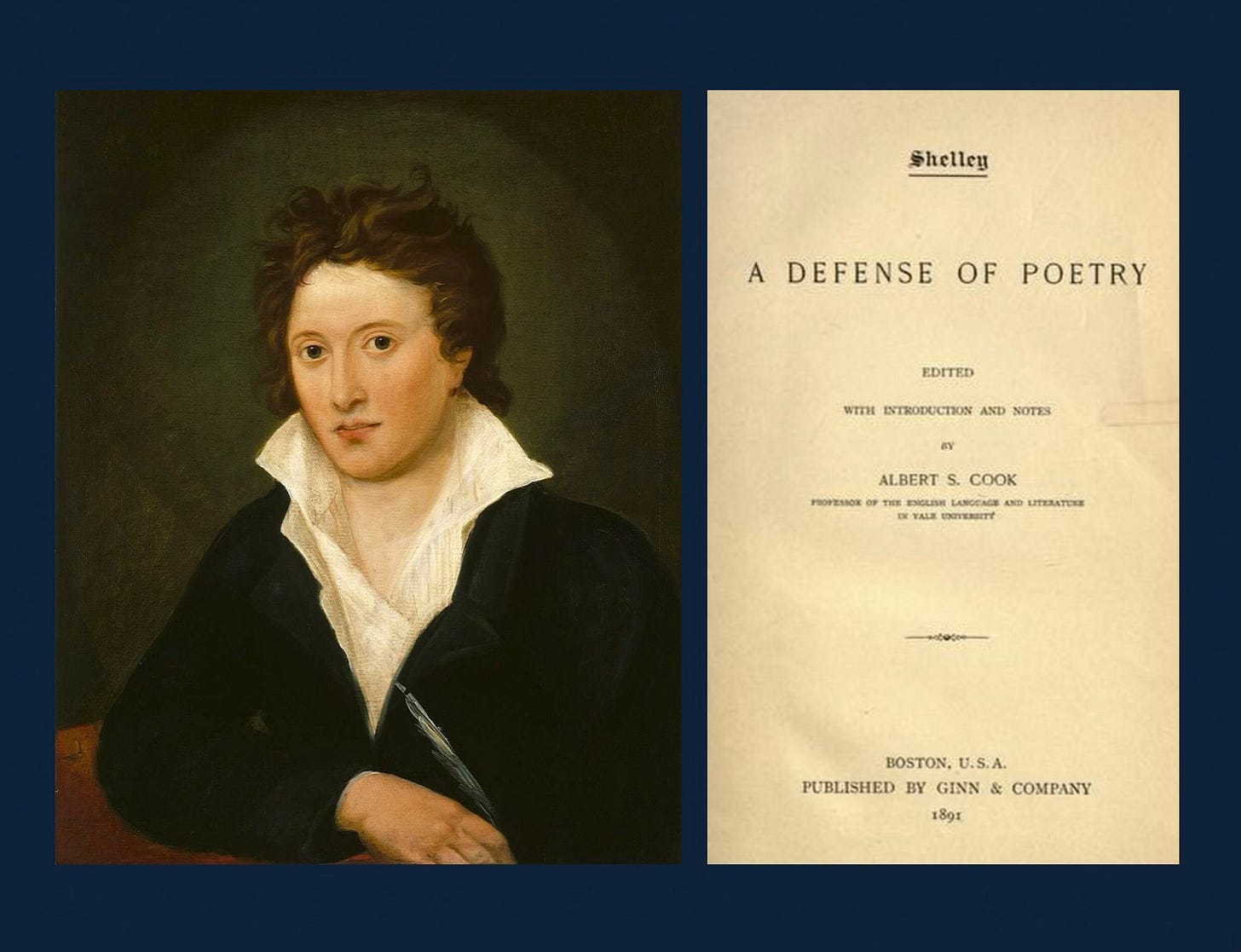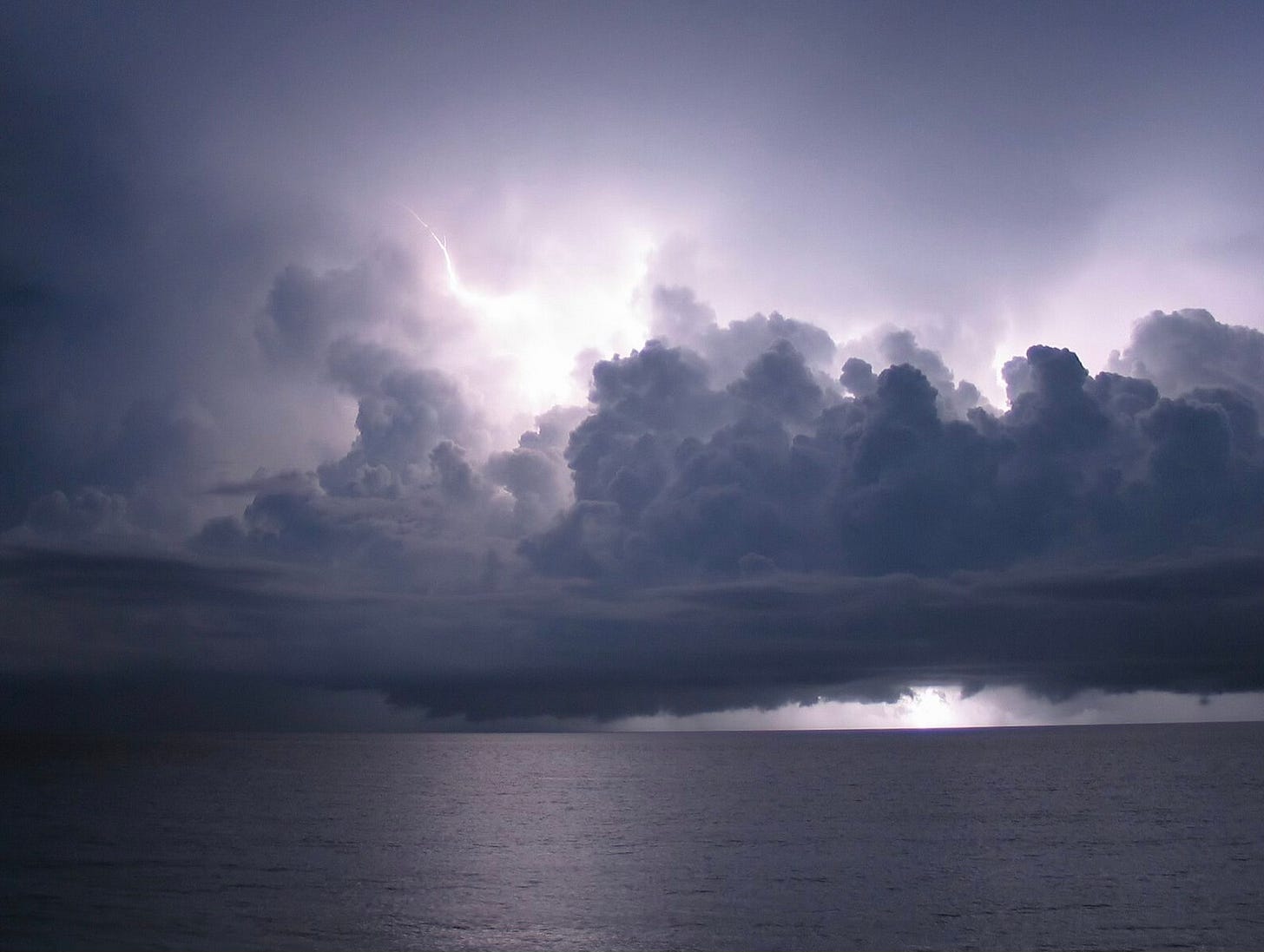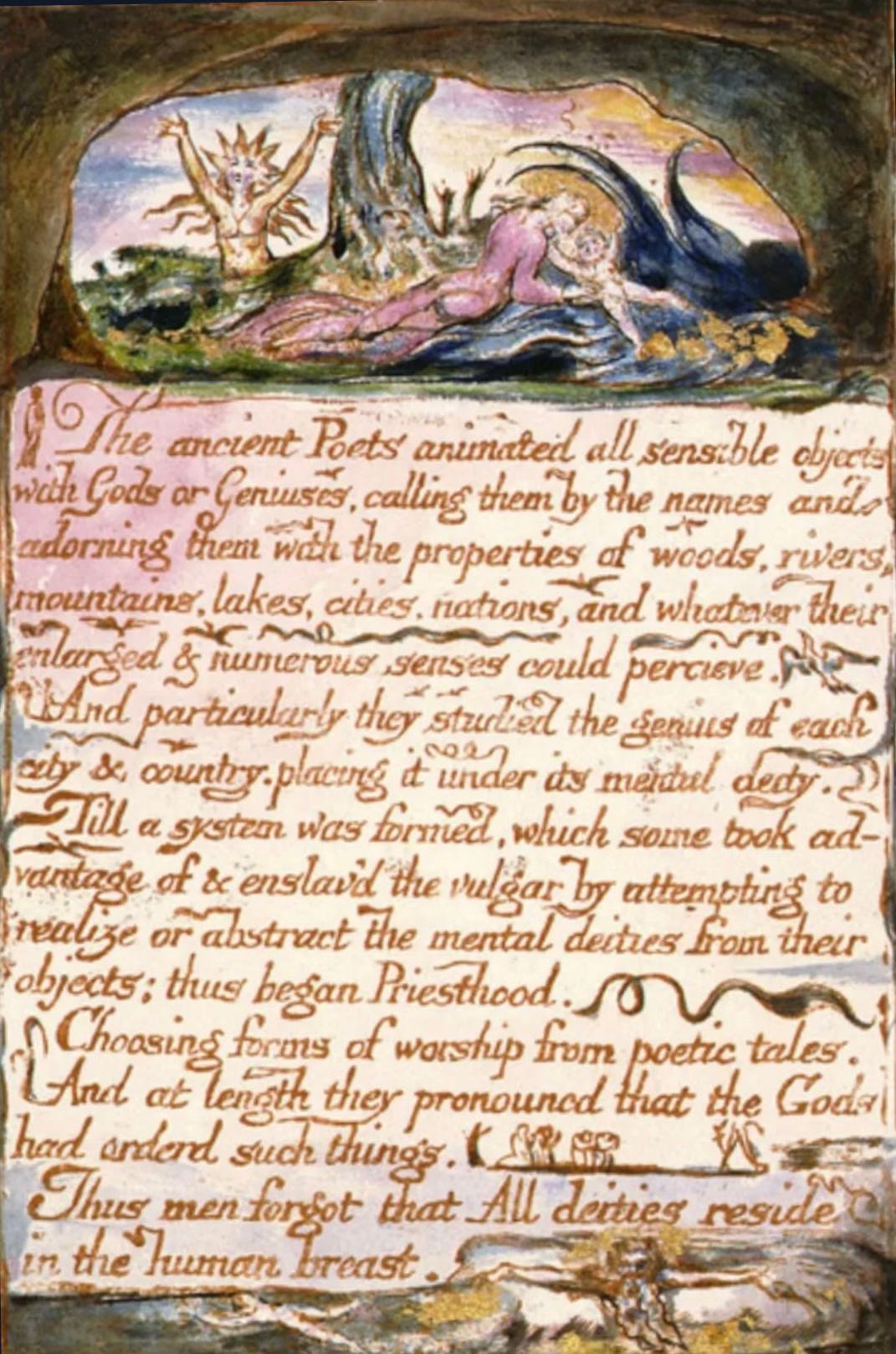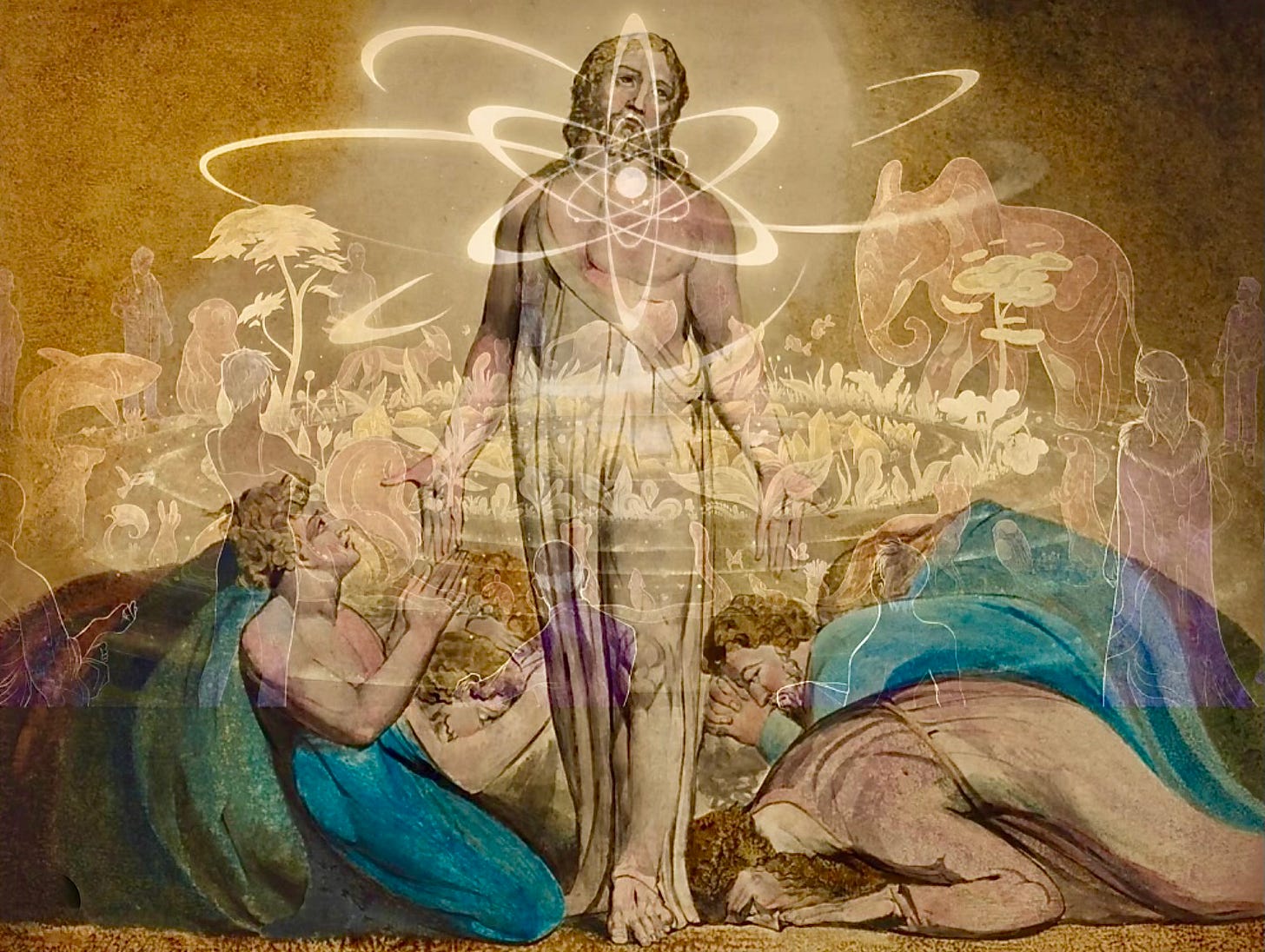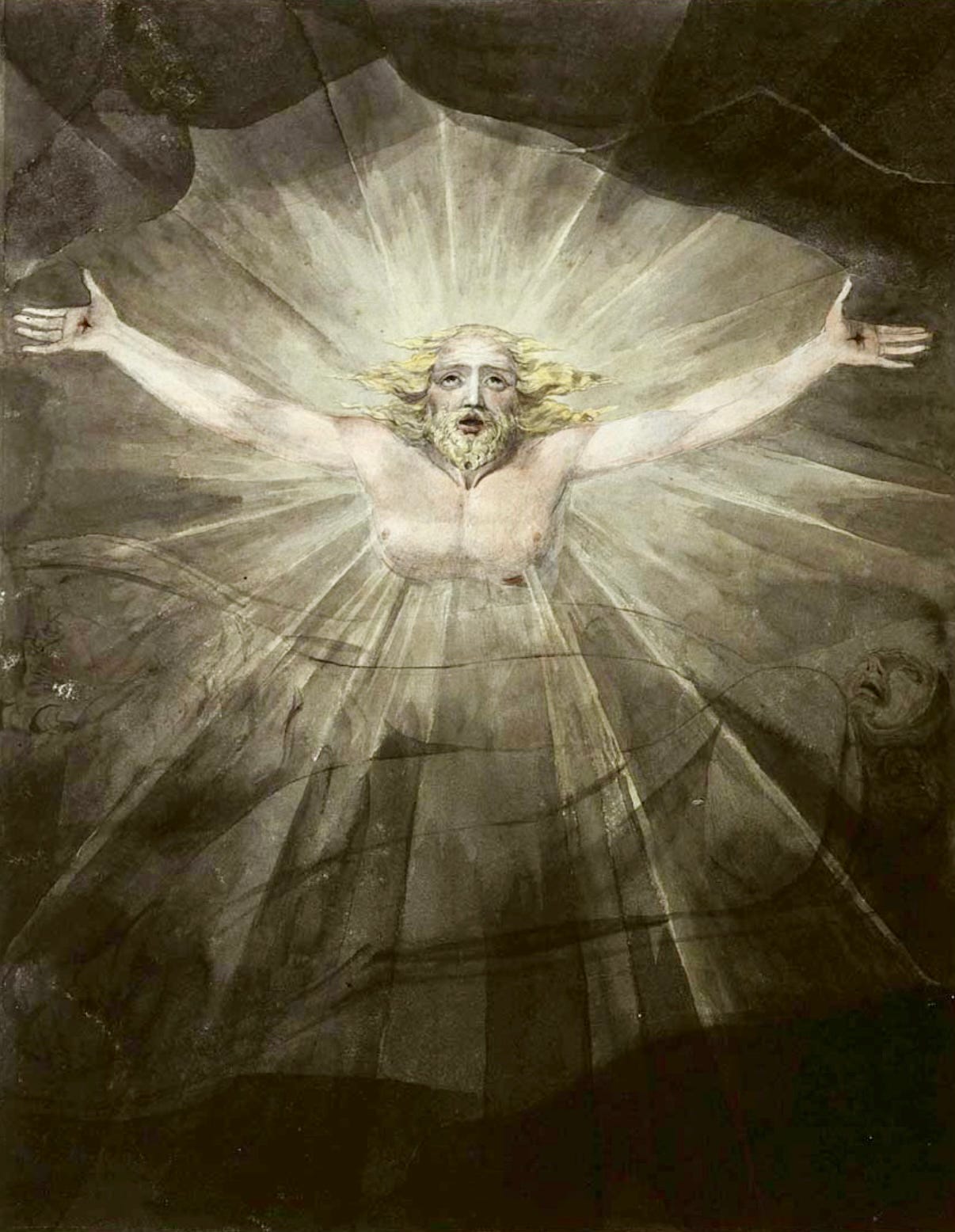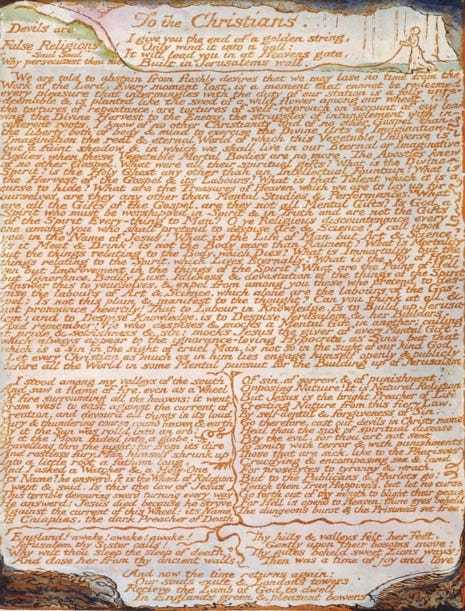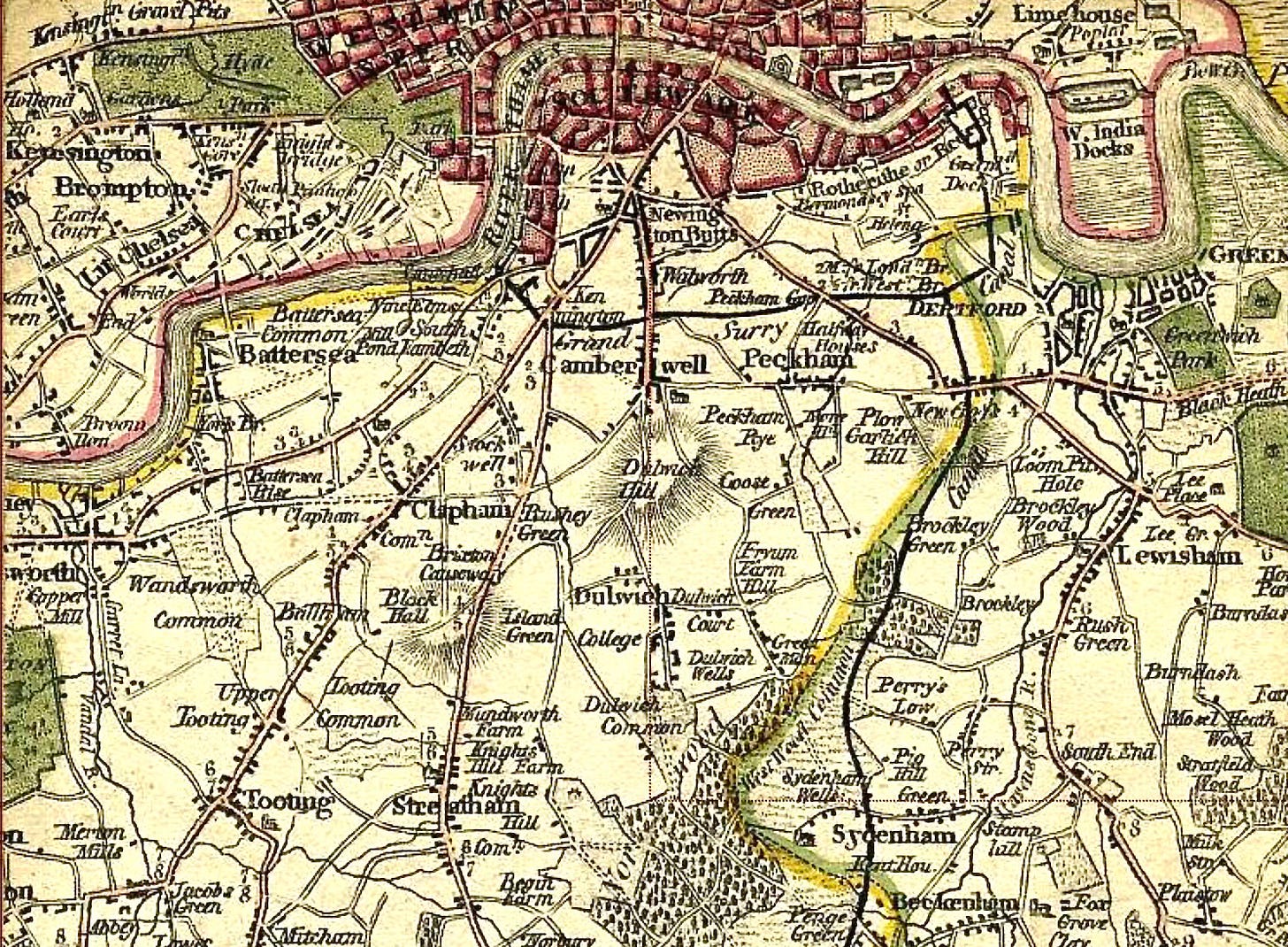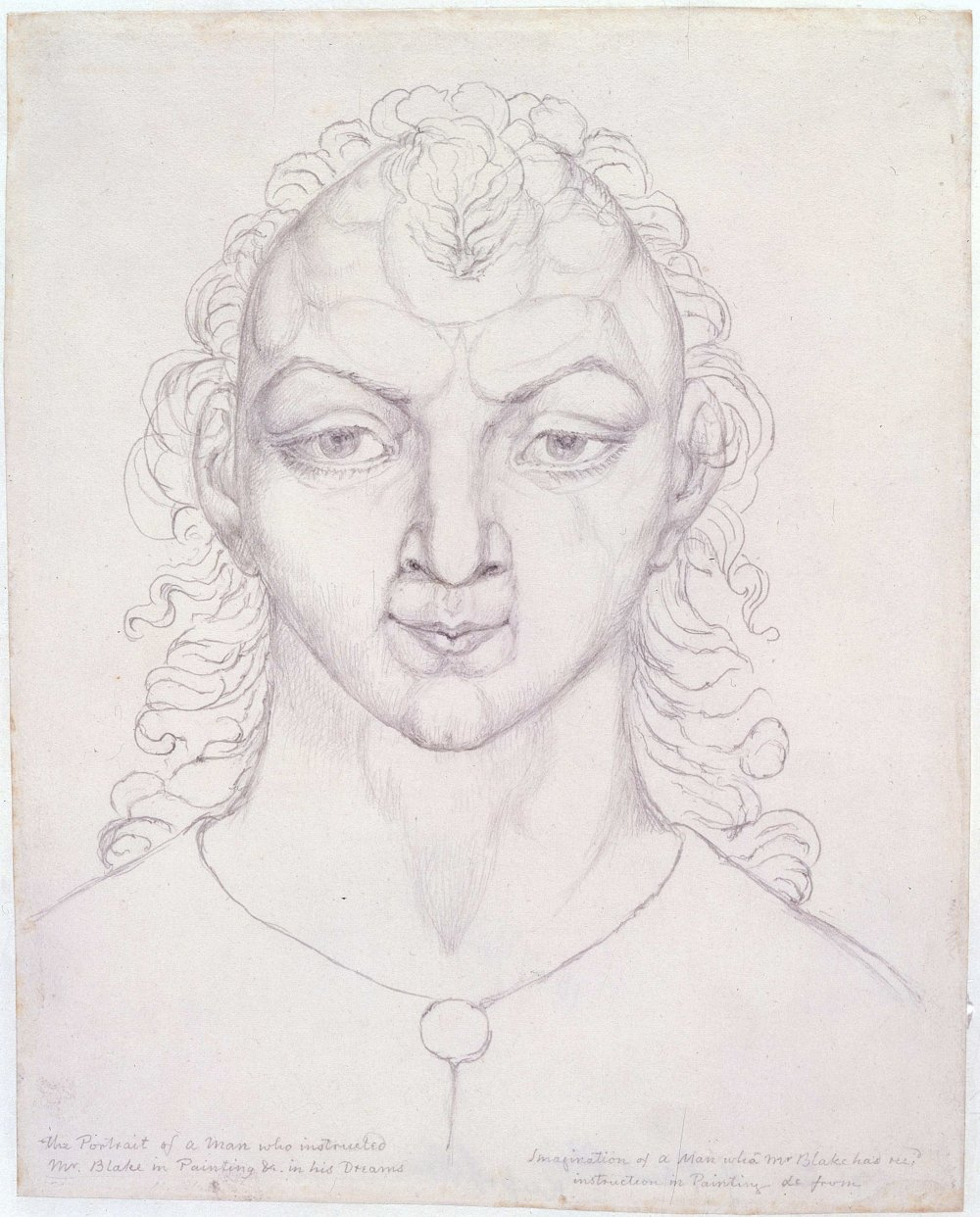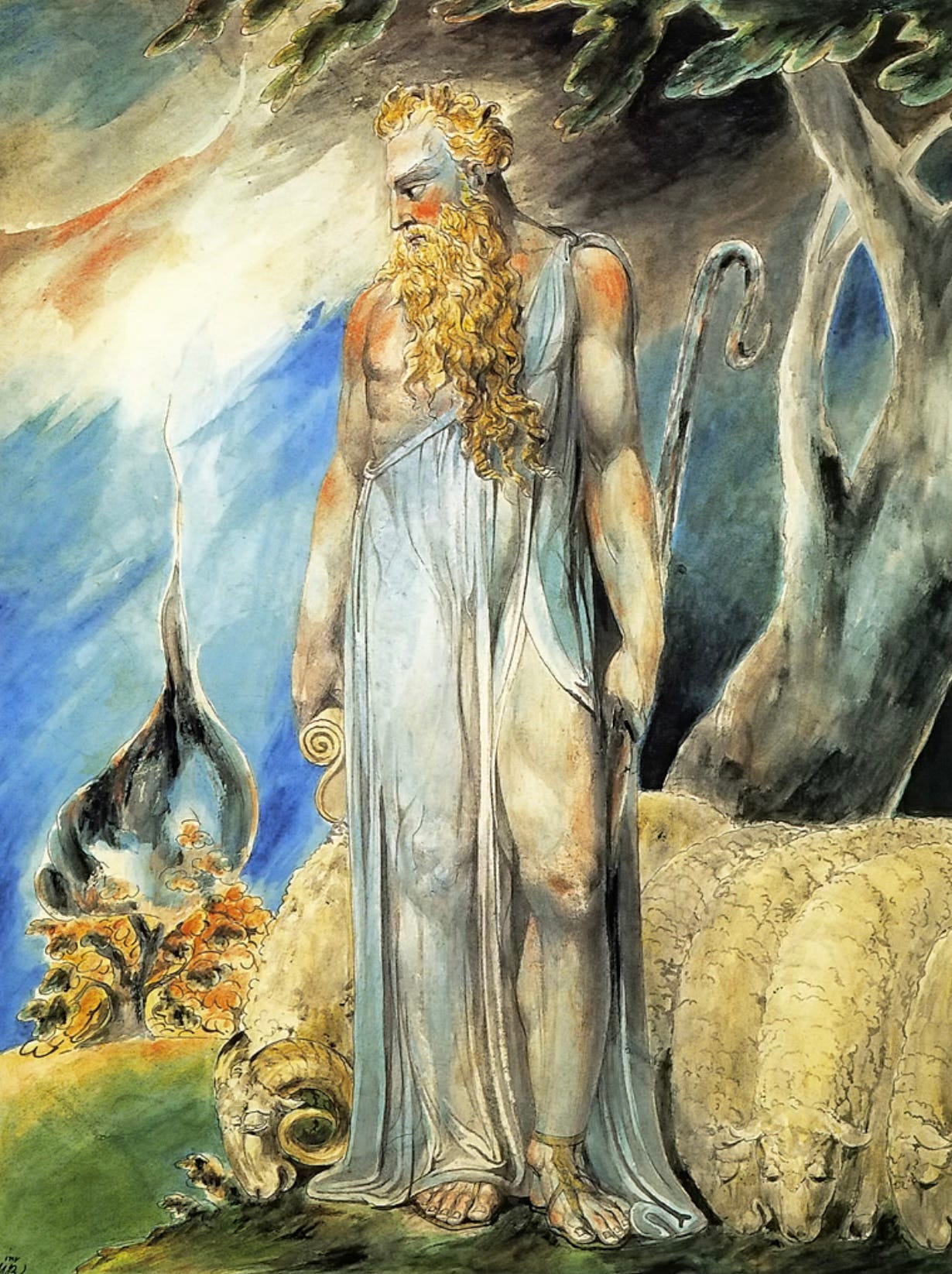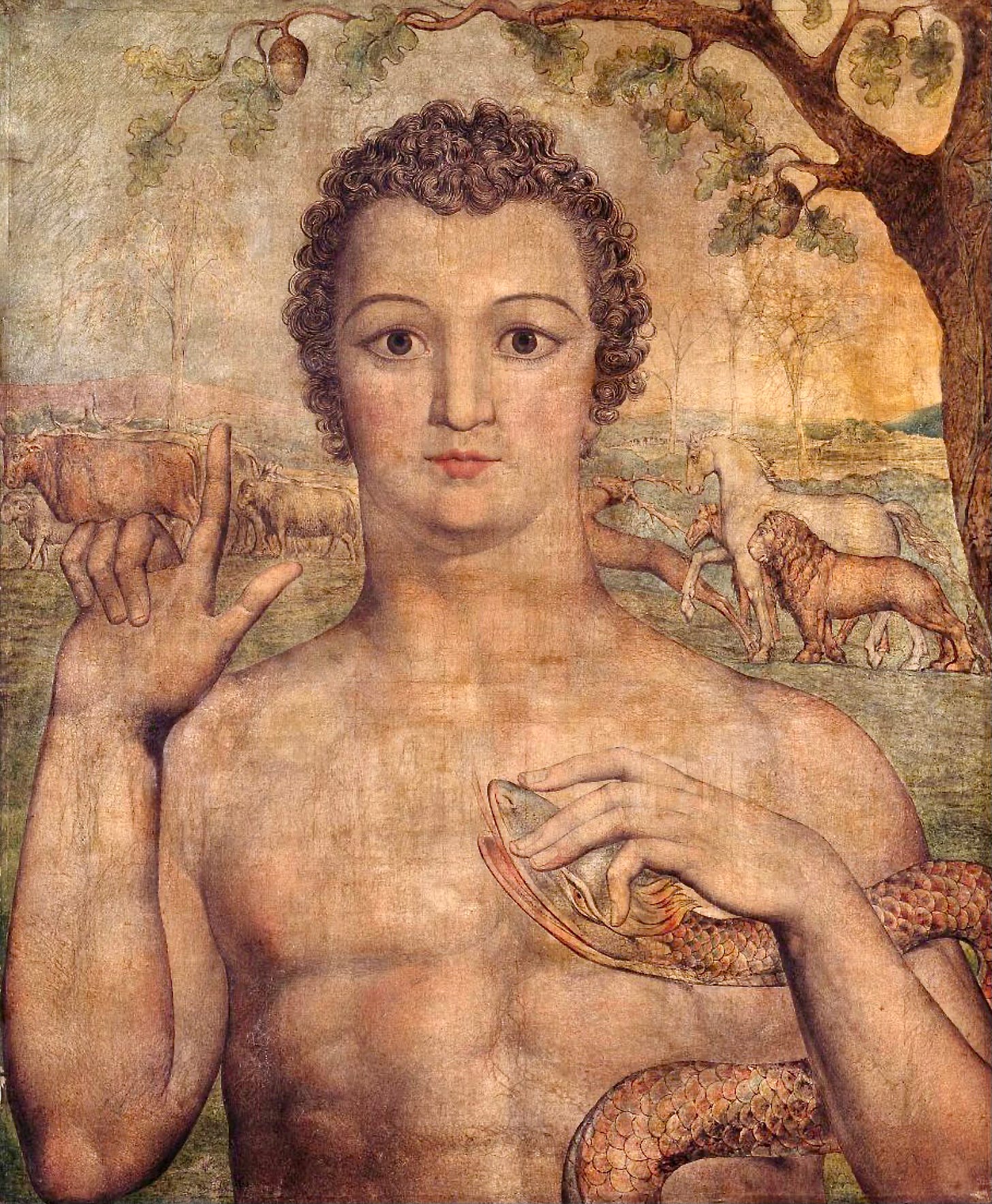The Infinite IAM: Coleridge, Blake, and the Primary Imagination
The Poet and God: Participating in the Wave Potential Field
‘Man is confronted with a world that alludes to something beyond itself, to a truth beyond experience. We do not perceive it. We have no knowledge; we only have an awareness. We witness it.’ - Abraham J. Heschel, ‘Between God and Man’
Introduction: Coleridge and the primary imagination
Samuel Taylor Coleridge (1772–1834), portrait by Peter Vandyke, 1795
In Chapter XIII of his Biographia Literaria, a remarkable fusion of literary criticism and personal autobiography which Coleridge published in 1817, the poet formulated his famous concept of the imagination or ‘the esemplastic power’, meaning ‘shaping or having the power to shape disparate things into a unified whole’ - it was a term he himself coined, from the Greek es hen, meaning ‘into one,’ and plassein, meaning ‘to mould’. In other words the term itself was an example of what it pointed to.
Coleridge’s formulation would come to define and articulate not only the Romantic conception of imagination, but also touch on the nature of God, being, perception, and our implicit relation to the universe:
The IMAGINATION then I consider either as primary, or secondary. The primary IMAGINATION I hold to be the living Power and prime Agent of all human Perception, and as a repetition in the finite mind of the eternal act of creation in the infinite I AM.
The secondary I consider as an echo of the former, co-existing with the conscious will, yet still as identical with the primary in the kind of its agency, and differing only in degree, and in the mode of its operation. It dissolves, diffuses, dissipates, in order to re-create; or where this process is rendered impossible, yet still at all events it struggles to idealize and to unify. It is essentially vital, even as all objects (as objects) are essentially fixed and dead.
FANCY, on the contrary, has no other counters to play with, but fixities and definites. The Fancy is indeed no other than a mode of Memory emancipated from the order of time and space; while it is blended with, and modified by that empirical phenomenon of the will, which we express by the word CHOICE. But equally with the ordinary memory the Fancy must receive all its materials ready made from the law of association.
‘Fancy’ is probably what most people think of when they use the term ‘imagination’, such is the level of both popular and philosophical misunderstanding and confusion on the subject, and Coleridge is keen to distinguish the two processes or faculties. As psychiatrist McGilchrist notes, delineating the differences, imagination is ‘genuinely creative, in the sense that it brings new experience onto being’, whereas fancy or fantasy ‘merely recombines what we are already familiar with in a new way’ (The Master and his Emissary). These two distinct modes can be identified with the right and left hemisphere’s mode of seeing and operating, respectively:
This is the distinction between fantasy, which presents something novel in the place of the too familiar thing, and imagination, which clears away everything between us and the not familiar enough thing so that we see it itself, new, as it is. Wordsworth, the most original of poets, was mocked for the insistent return of his gaze to what had been seen a thousand times before in an attempt to se it for the first time. (McGilchrist, ibid.,)
The first generation of so-called (but, as we shall see, poorly-named) ‘Romantic’ poets and philosophers were the first to significantly identify and articulate this aspect of reality, and our involvement with it. No other previous generation had understood - or been forced to understand - that human perception was not some passive act, like a mirror simply reflecting an ‘objective’ world outside it, which had characterised almost all previous speculation on the subject, but was profoundly involved, entangled, and participatory in that perception - constantly co-creating the reality it saw and helped to make ‘real’ - or rather a reality which emerged through this very process of mutual co-arising or ‘esemplastic’ formation.
Schelling, the great German philosopher of the same generation (1775–1854) had earlier used the word ‘Ineinsbildung’ to denote this new recognition of the interweaving of opposites which were involved in perception, and which actually constituted what we call ‘perception’ – part of the awakening of the age to the vast polar forces which both scientists (such as Priestley, Franklin, and Goethe) and philosophers (such as Schelling, Fichte, and Hegel) were now discovering actually generated the world, and through which and with which and in which we ourselves emerge into being.
Grant me a nature having two contrary forces, the one of which tends to expand infinitely, while the other strives to apprehend or find itself in this infinity, and I will cause the world of intelligences with the whole system of their representations to rise up before you. (Coleridge, Biographia Literaria. Here Coleridge attributes this attitude to what he calls the ‘transcendental philosopher’ - e.g., Fichte, Schelling, and Kant. It was no surprise that this generation of thinkers were to ‘discover’ and formulate the polar nature of both magnetism and electricity, and of imagination itself).
Perception, as Coleridge suggests in his development and extension of Schelling’s insight, participates in this deeper dynamic, creative, process, and is an echo of it - a ‘repetition’ of it, and of the great underling currents within which ‘objects’ are moulded into unity, into living form - forms that are also, as Blake recognised, intimately dependent upon the organs which behold them for their reality (even ‘The Suns Light when he unfolds it’, he observed, ‘Depends on the Organ that beholds it’).
Blake, frontispiece to ‘For the Sexes: The Gates of Paradise’ (1793). Man, like the chrysalis/emergent butterfly, is a vital product of contrary and co-dependent forces, as are his eyes - and as are all perceived things, which exist at the mutual meeting-place and esemplastic communion between unfolding and beholding - that is, which depend upon mutual ‘depending’, as Blake suggests here. Blake is correcting the Newtonian astigmatism which held that human optics were simply a one-way process of light entering the eye and us just somehow seeing things.
Coleridge’s first substantial definition of imagination actually comes at the beginning of his Lecture on the Slave Trade (1795), where he had referred to ‘the restless faculty of Imagination’ and talked about issues of creativity and ‘combination’, of imagination as not only a moulding and shaping agency but also a ‘vivifying’ power or spirit (the implication being that the imagination is something that is actually alive, or can breath life into things - into ‘objects’ which as objects ‘are essentially fixed and dead’, as Coleridge had noted).
This restless, transformative aspect of imaginative processes seemed to him to both reflect and participate in much wider evolutionary processes of transformation and movement – hence its role in what he strikingly calls in his 1795 Lecture ‘the ascent of Being’, and which Shelley also alluded to in his great revolutionary poem Queen Mab (1813). Indeed, in the very last lines of that poem, Shelley presents life, in all its great variety of forms, as embodying and transmitting an equally ceaseless and ‘necessarily beneficent’ evolutionary process:
And life, in multitudinous shapes,
Still pressing forward where no term can be,
Like hungry and unresting flame
Curls round the eternal columns of its strength.
Percy Bysshe Shelley (1792–1822). Shelley, like Keats and Byron, were part of the second wave or generation of ‘Romantic’ writers (Blake, Wordsworth and Coleridge belonging to the slightly older generation - though their lives overlapped and interlocked). As psychiatrist Iain McGilchrist has recently observed, however, the term ‘Romantic’ to describe this series of extraordinarily innovative, aware, rigorous, scientific, sophisticated, and acute thinkers and writers is a highly misleading and lazy categorisation, one often made by those who are too dreamy, vague, and ‘Romantic’ themselves to actually read them. Contemporary quantum physics, psychoanalysis, ecological awareness, democratic political radicalism, therapy, field theory, as well as our modern understandings of what creativity and expression involve, can all be traced to their thought, and often appear as a series of footnotes and embellishments of their original groundbreaking insights.
These writers and thinkers - Coleridge, Shelley, Wordsworth, Blake - sensed a profound resonance and relationality between what they were doing as creative artists, and the activity they saw all around them within the interconnected and interdependent ‘web of being’ as Shelley referred to it in Queen Mab - the constant transmutation of form, the mysterious and unwilled coming-into-being, and the vivifying and implicit energy within existence itself. Thus, Wordsworth observes:
I have felt
A presence that disturbs me with the joy
Of elevated thoughts; a sense sublime
Of something far more deeply interfused,
Whose dwelling is the light of setting suns,
And the round ocean and the living air,
And the blue sky, and in the mind of man:
A motion and a spirit, that impels
All thinking things, all objects of all thought,
And rolls through all things. Therefore am I still
A lover of the meadows and the woods,
And mountains; and of all that we behold
From this green earth; of all the mighty world
Of eye, and ear, - both what they half create,
And what perceive …- Wordsworth, Lines Written a Few Miles above Tintern Abbey (1798)
‘Half create, half perceive’ - this gets us to the heart of the shift that was occurring during this period: the recognition that we are profoundly involved within the world, not separate, detached, and disembodied spectators of ‘it’: that referring to it as an ‘it’ was itself an act of cultural conditioning which brought into being a delusory and disconnected world.
Interestingly, this idea of a vast transforming and transformative ‘imagination’ working within much larger processes, indeed evolutionary and cosmic formations, has recently been put forward by progressive biologists such as Michael Levin and Rupert Sheldrake. In his speculations of a possible wider imaginative field underlying all of reality, Sheldrake for example evokes similar Coleridgean ideas of restlessness, change, animation, and formation:
The universe is a growing, developing organism, which is differentiating within itself, forming new forms and patterns - an evolutionary process that on earth has given rise to all the forms of animal and plant life - all the different kinds of microbes - to ourselves, and to the many and varied forms of human culture.
What kind of creativity could underlie all this processes? One [position] is the materialist view that says the whole thing is entirely due to blind chance. That there’s nothing but a kind of darkness of blind material processes going on, and then by blind chance new things happen. The other model for understanding creativity I think is provided by our own imaginations. Our imaginations are not full of fixed Platonic ideas which are always the same, like Platonic minds. They’re ongoing, changing, dynamical processes with a kind of creative richness that always surprises us.
So, then the question is: could this creativity in nature be a product of the imagination of Gaia, of the Gaian mind, could it be a product of the cosmic imagination, could there be a kind of imagination working in nature which is similar to our own imaginations, could our own imaginations be just one conscious aspect of an imagination working through the whole natural world, perhaps unconsciously as it works underneath the surface of our dreams, perhaps sometimes consciously, and could this ongoing imagination be the basis of evolutionary creativity in nature just as it is in the human realm?
‘Could there be a kind of imagination working in nature which is similar to our own imaginations?’: Sheldrake discussing ideas of chaos, creativity, and imagination with Terence McKenna in 1995.
But it was Coleridge and Wordsworth, from the earlier generation of ‘Romantic’ poets and thinkers, who first publicly formulated these concepts, drawing both on progressive French materialism and German idealist philosophy. ‘To develope the powers of the Creator,’ Coleridge observed in his 1795 lectures,
is our proper employment – and to imitate Creativeness by combination our most exalted and self-satisfying Delight. But we are progressive and must not rest content with present Blessings. Our Almighty Parent hath therefore given to us Imagination that stimulates to the attainment of real excellence by the contemplation of splendid Possibilities that still revivifies the dying motive within us, and fixing our eye on the glittering Summits that rise one above the other in Alpine endlessness still urges us up the ascent of Being, amusing the ruggedness of the road with the beauty and grandeur of the ever-widening Prospect. Such and so noble are the ends for which this restless faculty was given us – but horrible has been its misapplication.
‘The ascent of Being’. Image: ‘Wanderer Above the Sea of Fog’ by Caspar David Friedrich (c. 1818). The great Romantic philosophers and writers were all deeply aware that the universe, far from being the dead mechanism of the earlier ‘Enlightenment’ age, was essentially alive, responsive, relational, dynamic, and awake.
‘a repetition in the finite mind of the eternal act of creation in the infinite I Am’. All imaginative perception is like this: both a resonance and a recreation
To see a World in a Drop of Rain. But where are you seeing this?
This is one of Coleridge’s most important statements about the imagination, and it foreshadows the definitions of primary and secondary imagination made in his Biographia Literaria. Rather than being simply a faculty for rearranging materials fed to it by the senses and the memory (by the past, by dead, mechanical processes of assembly - which is how the rational mind, the left hemisphere mind, ‘sees’ or rather conceptualises about reality), the imagination is an immediate, living, shaping and ordering power, a ‘modifying’ power which senses in the world around it that presence which it itself diffuses through the world, like the fragrance of a rose:
Ah! from the soul itself must issue forth
A light, a glory, a fair luminous cloud
Enveloping the Earth —
And from the soul itself must there be sent
A sweet and potent voice, of its own birth,
Of all sweet sounds the life and element!– Coleridge, Dejection: An Ode
The mind is not, Coleridge insists, the passive recorder of sense impressions; it is not (as for the Lockean empiricist) an inert block of wax on which external objects somehow simply imprint themselves. On the contrary, for Coleridge as for Wordsworth, perception is a bilateral rather than a unilateral activity, reverberative rather than sequential - direct sensory experience is a stimulus that evokes a response and involves and indeed incarnates (to borrow a phrase from Wordsworth) ‘an ennobling interchange/ Of action from within and from without’ (The Prelude).
We don’t simply ‘see’ reality: human perception is a vastly complex and itself imaginative construction or generative process, involving multiple domains, networks, nerves, and cognitive, psychological and physiological aspects - even to see and recognise the image above requires thousands of separate processes and acts. And each person sees that image slightly differently, according to their unique, particular perspectives and state. As writer Anaïs Nin observed, we don’t see things as they are, we see things as we are: in other words, it is not ‘is’ that is key, but ‘as’ - it’s a deeply relativistic, perspectival (as/is) universe, all the way down. This has huge implications for us as human beings, as both the Romantics and the leading quantum physicists recognised. ‘I consider the unpredictable change of the state by a single observation’, noted Niels Bohr, ‘to be an abandonment of the idea of the isolation of the observer from the course of physical events outside himself’. This effectively demolishes the idea of the mind as a ‘mirror’ - the delusion that there exists an independently existing ‘external’ universe which we can simply somehow see and reflect. ‘Separation of the observer from the phenomenon to be observed is no longer possible’, as Werner Heisenberg confirmed.
Perception – like every other living activity – is a mutual, living interchange, an encounter, a communion and ‘coming-into-being’, a radical meeting in which both participants are changed or ‘altered’, as Blake notes (‘For the Eye altering alters all’ - The Mental Traveller).
Coleridge’s and Wordsworth’s observations about the crucial differences between a merely mechanical form of seeing, or putting things together (‘fancy’), and a genuinely imaginative mode of perceiving and creating, have received remarkable corroboration in recent studies of brain neurology and hemispheric physiology, as McGilchrist explains. ‘The left hemisphere “creates” newness’, he notes, ‘by recombining in a novel fashion what is already known, not as imagination does, by allowing something that we thought we knew to be truly revealed for the first time’ (The Master and his Emissary, italics added).
The movement generally known by the word ‘Romanticism’ might therefore more properly be regarded as the radical reawakening of the right hemisphere mode of understanding the world and relating to it, the right brain being that hemisphere which is most deeply and veridically in touch with reality, on almost every criteria. It is the right hemisphere that has ontological primacy, McGilchrist observes, noting that this primacy operates on every level: ‘Primacy could just mean coming first, in the sense that childhood comes before maturity. But I do not only mean that the right hemisphere starts the process of bringing the world into being. I mean that it does so because it is more in touch with reality, and that it has not just temporal or developmental priority, but ontological supremacy’:
What we know had to come into being first for the right hemisphere, since by definition at first it is new, and the right hemisphere delivers what is new as it ‘presences’— before the left hemisphere gets to re-present it. (ibid)
Modern neurological findings are radically opening our eyes to the ways in which our very embodiment delivers us a world, indeed many worlds, revealing in the process how truly acute and perceptive the earlier generation of writers and thinkers were about the nature of imaginative reality.
Romanticism in fact demonstrates, in a multitude of ways, its affinity for everything we know from the neuropsychological literature about the workings of the right hemisphere. (McGilchrist, ibid.).
The World of Imagination
The purpose and premise of hyper-left brain Enlightenment Rationality was to eradicate such co-creativity: in fact ‘to destroy Imagination’, as Blake suggests - our ability to perceive the infinite, and our link with the divine and transcendent, which constitutes the true nature of reality. ‘My contention is,’ notes psychiatrist and philosopher Iain McGilchrist, in what could be a literal paraphrase of Blake, ‘that imagination, far from deceiving us, is the only means whereby we experience reality’:
It is the place where our individual creative consciousness meets the creative cosmos as a whole. It is no coincidence that the same Indo-European root, present in classical Greek, indicates both to know and to generate or to be born. It is the virtual, re-presented world of the left hemisphere that is the deceit.
Imagination is not, as it is sometimes conceived, the capacity to conjure the unreal, but, for the first time, to see the real - the real that is, for reasons of deeply ingrained habit, no longer present to us. It is not a means of placing something else between us and the world, but of removing the accretions that prevent us from that world's fuller realisation. To see is not just to register sense-data, but to see 'into’ the life of what is seen; and 'through' it to the greater picture that lies beyond it, is implicit in it, and makes sense of it in terms of the totality of experience. (The Matter with Things, italics added)
Thus the product in any given act of perception is a modified combination of the-percipient-and-the-thing-perceived, and is, as Coleridge asserts in Biographia, neither a subject (perceiver) nor an object (thing-perceived) exclusively, but rather the most original and fruitful union of both.
Image: theoretical physicist John Archibald Wheeler’s original illustration of his ‘participatory’ universe model, suggesting how the observed is at a fundamental level involved with the observer, and vice-versa. ‘The universe through the eyes of man becomes conscious of itself’, altering both in the process. Coleridge’s speculations on the unity of observed and observed in his Biographia has found startling corroboration in the recent formulations and realisations of quantum field theory.
As Coleridge scholar John Spencer Hill remarks, ‘in and through the act of blending “thoughts” and “things”, the (primary) Imagination functions as a fusing, synthesising power – an esemplastic power whose operation generates a new reality by shaping parts into wholes, by reconciling opposites and drawing unity from diversity’:
It is not, as for the neoclassical critic, a mechanical faculty (‘aggregative and associative’); it is, rather, a vital and organic power common to all men, which permits the mind to penetrate beneath the transitory surface of the material world, that is, to see into the life of things and experience the intimate relationship between the perceiving mind and the objects of its contemplation.
The germinal potency of Coleridge’s theory of Imagination lies in his rejection of passive perception, his recognition of perception as integrative, poietic, and necessarily correlative with feeling, and his understanding that the poetic Imagination grows out of a seamless bond between perception, memory, association, feeling, intellect, and a sense of language as being in some way autonomous. (Hill, Imagination in Coleridge, 1978).
The germinal potency of the theory of Imagination lies in Coleridge’s rejection of passive perception. This is the key insight, separating Romantic and modern understandings of perception and vision from the earlier naive and erroneous ‘mirror-mind’ model. For the mind, Coleridge remarked to Poole in 1801, is not, as materialists maintain, ‘a lazy Looker-on on an external world’, and therefore there is ‘ground for suspicion, that any system built on the passiveness of the mind must be false, as a system’.
This includes and applies to many previous ‘spiritual’ as well as philosophical and materialist systems, which were perhaps simply not in a position to be able properly to understand the actual nature of the brain, the eye, the mind, perception, or the interdependence of subject and object, and who sought to disconnect and dissociate ‘pure reason’ and ‘pure awareness’ from anything so gross and messy and embodied as living, imaginative, perceptual systems. As the Bhagavad-Gîtâ disastrously counsels, ‘Abandoning without reserve all desires born of the imagination, by the mind curbing in the aggregate of the senses on every side, little by little let him gain tranquillity by means of Reason controlled by steadiness’ (translated by Annie Besant and Bhagavan Das, 1905). Notice the preeminence and elevation of ‘Reason’ here, and its opposition to Imagination.
Many old and orthodox religious traditions never even mention the word ‘imagination’, or do so only to mock it. Krishnamurti is typical of many: ‘Imagination perverts the perception of what is; and yet how proud we are of our imagination and speculation’ (Commentaries on Living). For him, as for so many others (including most of the leading scientists and philosophers of the Enlightenment period), the aim and concept of perception is based on the abstract notion of ‘clarity’, through the deliberate bleaching and draining from perception of any trace of the living organism that is doing the perceiving or sensing - any trace of ‘subjectivity’.
In traditional Buddhism there is not even a word for ‘imagination’ - a neat way of simply removing the reality from the picture; instead, the Buddha warns against papañca, or ‘proliferation’, drawing attention to ‘a negative and distorting way in which our mind’s power of (primary) imagination works’, as Dhivan Thomas Jones aptly puts it (‘Through a Blue Chasm: Coleridge, Wordsworth and the Buddha on Imagination’, 2013). Instead, the Buddha recommends cultivating sati, a term often translated as ‘mindfulness’ or ‘awareness’ but actually deriving from a Sanskrit term (sar or smṛ) meaning ‘to remember’, or ‘to recollect’. It is a system which cultivates memory, and emptiness.
A similar system is found in Krishnamurti. As Professor Vedaparayana notes, ‘Krishnamurti distinguishes between two kinds of thought - the factual and the psychological’:
The factual thought is strictly logical, objective and precise; it comprises knowledge which is well-reasoned, sane and experimented; it includes knowledge which is essential for our daily living and biological well-being; it is related to the scientific and technical knowledge like driving a car, going to the moon, and so on; it also refers to linguistic, mathematical, historical and geographical knowledge which contributes to the growth of civilization. (‘J. Krishnamurti’s Philosophy of Psychology’, by G. Vedaparayana.)
You can see where Krishnmurti’s kind of ‘strictly logical, objective, and precise’ mode of seeing is heading. And he contrasts this ‘factual thought’ with what Vedaparayana calls ‘psychological’ thought, which Krishnamurti himself defines as ‘a messy conglomeration of irrational knowledge’ - anything which opposes the sort of bleached, empty seeing which he quaintly terms ‘clarity’.
But as Blake remarked, challenging the supremacy of these sterile systems in his own day, and extending from Plato and Pythagoras to Newton:
When Rintrah gave Abstract Philosophy to Brama in the East:
… To Trismegistus. Palamabron gave an abstract Law:
To Pythagoras Socrates & Plato.… Till a Philosophy of Five Senses was complete
Urizen wept & gave it into the hands of Newton & Locke- Blake, The Song of Los (1795)
This ‘abstract’ philosophy was precisely the abstracting of imagination from perception, of the subject from the unified object-subject field, of the spirit from the world, and it has dominated our way of thinking and, even worse, our way of seeing ever since - for well over two thousand years, as Blake suggests here. What it generates is the delusion of ‘objects’, an ‘objective’ world that is conceptualised as being simply ‘out there’ - ‘factual’, as Krishnamurti would say. It is therefore based on what Blake calls the ‘objecting power’ within the brain: ‘the Reasoning Power/An Abstract objecting power’:
… it is the Reasoning Power,
An Abstract objecting power, that Negatives everything.
This is the Spectre of Man: the Holy Reasoning Power- Blake, Jerusalem
The ‘objecting power’ of such rationality neatly describes the way in which fallen egoic reason operates and processes experience: it captures both its objectifying stare and stance and also its tendency to ‘object to’ everything. In many ways, as Blake suggests, the history of all hitherto existing philosophy has therefore been a history of ‘Abstract Philosophy warring in enmity against Imagination’ (Jerusalem). The exclusion of the imagination from these philosophies and traditions is no coincidence, but part of a sustained campaign to marginalise, exclude, and belittle the embodied, the ‘impure’, the living, the subjective, and the imaginative.
It is in some ways rather a pathological stance. Indeed, McGilchrist characterises this abstract and abstracting attitude of ‘an excessively detached, hyper-rational, reflexively self-aware, disembodied and alienated condition’ as being common to both schizophrenia and post-Enlightenment philosophy. As he observes, the ‘conscious effort to distance oneself from one’s surroundings, refrain from normal action and interaction with them, suspend one’s normal assumptions and feelings about them and subject them to a detached scrutiny’ is ‘an exercise which in the non-mentally ill is normally confined to philosophers’ (The Master and his Emissary).
All these systems, whether esoteric and ‘holy’ (as with Hermes Trismegistus and Pythagoras) or ostensibly exoteric and material (the legacy of Newton and Locke), share an awkward, perhaps even rather an autistic, view of bodily life and of human life in particular. All these codes and abstract, holy Gods and dissociated powers tend to appeal to people who are, one might say, rather uncomfortable with their own humanity. It is this discomfort that the Urizenic program exploits so cleverly:
I am your Rational Power O Albion & that Human Form
You call Divine, is but a Worm seventy inches long
That creeps forth in a night & is dried in the morning sun
In fortuitous concourse of memorys accumulated & lost …
So spoke the Spectre to Albion. he is the Great Selfhood
Satan: Worshipd as God by the Mighty Ones of the Earth
Having a white Dot calld a Center from which branches out
A Circle in continual gyrations- Blake. Jerusalem
The Two Modes of Seeing: Reason and Imagination
The Abstract Objecting Power: Newton distancing the world, to see it ‘clearly’.
Blake’s and Coleridge’s understanding of the imagination also leaves open the possibility that the imaginative process of the mind may in its activity actually participate in or reflect much deeper and more fundamental process of formation. As Sheldrake conjectures, ‘could there be a kind of imagination working in nature which is similar to our own imaginations, could our own imaginations be just one conscious aspect of an imagination working through the whole natural world?’
In this sense, and this sense alone, our perception might be said to ‘mirror’ the world - not in being a passive left-hemisphere Representation of that world, and the supposed objects in that world, but through the very process of engaging with it and being formed by it, through it, and out of it. In that sense, Coleridge ruminates, the human mind and human vision might be said to be an image or ‘likeness’ of the ‘cosmic imagination’ (Sheldrake’s term), or in Coleridge’s more Christianised lexicon, made in ‘the Image of the Creator’ (letter to Poole, 1801). That is to say, generative, alive, bringing-into-being.
For perception – or ‘Primary Imagination’ as Coleridge calls it (‘the living Power and prime Agent of all human Perception’) – is in itself integrative, formative, constantly evolving, dissolving and recombining, and necessarily correlated with embodied feeling and sensitivity. It is a creative (birthing) activity in which images, ideas and feelings are fused and brought into being by the mind (‘the word ‘creative’, so mis-used and over-used by advertisers and accountants originally simply meant ‘growing’, or ‘to form out of nothing’ - from the Proto-Indo-European root ‘ker-’, meaning ‘to grow.’ It’s where we get the word Ceres from as well - as in the goddess of the wheat. The implication is that the mind itself is a garden or field out of which or through which forms emerge and blossom into being - and that the whole world is such a mind or field, in which we participate through this commingling activity.
All children are born with this garden, Blake suggests: ‘Man is Born Like a Garden ready Planted and Sown. This World is too poor to produce one Seed’ (Blake, ‘On Reynolds’). It was the job of the education system, and rationalised industrial capitalism, Blake believed, to decimate this garden in our heads. In this he seems to have had a point. As Roger Sperry, who won the Nobel Prize in 1981 for his pioneering work on split-brain research, has argued, ‘what it comes down to is that modern society discriminates against the right hemisphere’:
Experiments show that most children rank highly creative (right brain) before entering school. Because our educational systems place a higher value on left brain skills such as mathematics, logic and language than it does on drawing or using our imagination, only ten percent of these same children will rank highly creative by age 7. By the time we are adults, high creativity remains in only 2 percent of the population. (Sperry, 1974).
As his research suggests, what becomes ‘normal’ in contemporary society is actually the result of a highly artificial and selective emphasis on the cultivation of only left hemisphere skills: a society with only half their brains fully engaged. He pessimistically concludes that ‘our educational system and modern society generally ... discriminates against one whole half of the brain’ (Sperry, 1983).
Indeed, perhaps one of the reasons for Blake’s unusual integration of the right brain into his adult life was that he was lucky enough not to have received any formal education in this country. Sperry’s research seems further to corroborate Blake’s belief that whilst imaginative or ‘visionary’ perception has to be cultivated, it is also something so easy and immediate that every child has it. As a contemporary of Blake recalled, ‘he said to me that all children saw “Visions”and the substance of what he added is that all men might see them but for worldliness or unbelief, which blinds the spiritual eye’ (cited in Ackroyd, Blake, 1995).
This ‘spiritual’ or imaginative eye is precisely the one that rationalisers and mirror-mind philosophers seek to obliterate within us.
Full immersion: Children's art, cosmic participation. ‘This power is supremely human and is a part of every man’s birthright, and it makes each of us in a way a poet’. Image: Glad Day, or The Dance of Albion by William Blake (c. 1794)
Related to this ‘primary’ or foundational activity, and differing from it in degree but not in kind, as Coleridge observes, is the operation of the more consciously ‘Secondary’ imagination, a power or faculty which is latent but not equally developed in all humans (and which needs to be cultivated - another growing/ field metaphor). The imaginative faculty or process works not simply by synthesising phenomena but equally by dissolving them - a constant process of breaking down forms and then refashioning or re-forming them, to re-present or re-presence the common universe in such a way that we see it as if for the first time. As Shelley observed:
[‘The poetical faculty] reproduces the common universe of which we are portions and percipients, and it purges from our inward sight the film of familiarity which obscures from us the wonder of our being. It compels us to feel that which we perceive, and to imagine that which we know. It creates anew the universe, after it has been annihilated in our minds by the recurrence of impressions blunted by reiteration. (A Defence of Poetry, 1821).
In the language of contemporary neuroscience, it is a way of restoring the brain to a right hemisphere mode of seeing and relating to the world: as presence (rather than as mere re-presentation, in McGilchrist’s terms); as synthesising (and not merely analysing, as the left hemisphere is); as vivifying (and not simply abstracting and deadening, as the rationalising brain is), and as fundamentally entwined and participating in the reality it constantly experiences and delivers us.
In Shelley’s terms, speaking of these two fundamental, complementary, but mutually incompatible modes of being in the world, the imaginative and the rational: ‘The one is the το ποιειν, or the principle of synthesis, and has for its objects those forms which are common to universal nature and existence itself; the other is the το λογιςειν, or principle of analysis, and its action regards the relations of things simply as relations; considering thoughts, not in their integral unity, but as the algebraical representations which conduct to certain general results. Reason is the enumeration of qualities already known; imagination is the perception of the value of those qualities, both separately and as a whole. Reason respects the differences, and imagination the similitudes of things. Reason is to imagination as the instrument to the agent, as the body to the spirit, as the shadow to the substance’ (ibid.).
Shelley’s A Defence of Poetry, one of the greatest implicit explorations of brain lateralisation ever written. Ostensibly an analysis of ‘those two classes of mental action, which are called reason and imagination’, Shelley, like Blake, investigates the intimate and profound connections between, on the one hand, ‘reason’ and other left brain qualities such as the ‘calculating’ processes, ‘the principle of self’, and ‘analytical reasoning’, and on the other hand the ‘imagination’ and the ‘creative faculty’, ‘the principle of synthesis’, and the ‘divine’ aspect of consciousness that ‘participates in the eternal, the infinite, and the one’.
The Unconscious Imagination
What Coleridge terms ’primary’ imagination might perhaps therefore be best understood as spontaneous, involuntary, immediate, part of the foundational structure or movement of mind itself – perhaps even operating ‘unconsciously’, as Shelley suggests in A Defence of Poetry – as opposed to the secondary form, which Coleridge suggests is ‘co-existing with the conscious will’.
But the boundary here seems to be fluid, porous: as Shelley notes – and surely Coleridge would have been himself aware of this, as the author of poems such as Kubla Khan – poetic inspiration seems to act on the poet in a largely unconscious (right hemisphere) way, operating below and beyond the exertions of ‘conscious will’:
Poetry is not like reasoning, a power to be exerted according to the determination of the will. A man cannot say, ‘I will compose poetry.’ The greatest poet even cannot say it; for the mind in creation is as a fading coal, which some invisible influence, like an inconstant wind, awakens to transitory brightness; this power arises from within, like the colour of a flower which fades and changes as it is developed, and the conscious portions of our natures are unprophetic either of its approach or its departure.
Shelley could almost be talking about how flowers fade and change, as much as how the mind in creation does. He also draws our attention to the spiritual, psychological, and epistemological function and nature of poetic imagination in liberating us both from the dull, mechanical, conditioned responses and repetitions of the world of representation and memory, concept and measurement, and in connecting us to the true sources of life and animation in the universe within which we are surrounded and in which we totally participate in.
‘It is as it were the interpretation of a diviner nature through our own; but its footsteps are like those of a wind over the sea, which the coming calm erases, and whose traces remain only as on the wrinkled sand which paves it’ (Shelley, A Defence of Poetry). Dissolving and reforming : the nature of imagination, the nature of reality. As he writes in his poetic-scientific work ‘The Cloud’ (1820), imagining himself as the cloud: ‘I wield the flail of the lashing hail,/ And whiten the green plains under,/ And then again I dissolve it in rain,/ And laugh as I pass in thunder.’
Shelley deftly connects Coleridge’s earlier comments about ‘the film of familiarity’ in his Biographia Literaria (published just a few years before Shelley wrote his Defence), with these much wider cultural and theological contexts and conversations regarding the nature of creativity. By ‘film’, both Coleridge and Shelley are drawing attention to the patina of conditioned thinking which obscures us from seeing the world properly (immediately, spontaneously, as present and alive with us and within us).
This is the film of concepts, clichés, words, past associations - the mechanical, repetitive, mill-like obfuscation which imposes itself on our way of seeing and our way of being, through the processes of memory and rationality. Only imagination can dissolve these obfuscating scales and crustaceans - imaginative processes are as much about corroding and removing and unconcealing, or ‘unbuilding’ as Shelley terms it in The Cloud, as they are about ‘creating’ or moulding together.
Blake put it particularly vividly, drawing on an image from his own engraving practices working with copperplates and acid (through which his forms emerged), and seeing in this process a trace or echo of a much vaster cosmic, indeed apocalyptic, process:
The ancient tradition that the world will be consumed in fire at the end of six thousand years is true, as I have heard from Hell.
For the cherub with his flaming sword is hereby commanded to leave his guard at tree of life; and when he does, the whole creation will be consumed and appear infinite and holy, whereas it now appears finite and corrupt.
This will come to pass by an improvement of sensual enjoyment.
But first the notion that man has a body distinct from his soul is to be expunged; this I shall do by printing in the infernal method, by corrosives, which in Hell are salutary and medicinal, melting apparent surfaces away, and displaying the infinite which was hid.
If the doors of perception were cleansed everything would appear to man as it is, infinite.
For man has closed himself up till he sees all things thro’ narrow chinks of his cavern. (The Marriage of Heaven and Hell, italics added)
This is the true essence of creation and uncreation: ‘melting apparent surfaces away, and displaying the infinite which was hid.’
Burning it up: to see clearly is to see imaginatively, without filters, films, or fabrications. For mind itself is an imaginative medium, as Blake recognised: ‘The Imagination is not a State,’ he once observed, ‘it is the Human Existence itself’ (Milton a Poem). In modern terms, imagination might be seen as the basic operating system of all human perception. To see a tree clearly, Blake suggests, we have to burn up or dissolve the word ‘tree’ in our minds and also burn up or dissolve the idea or thought that it’s part of what we conceptualise as something called ‘Nature’, or being ‘over there’, or something ‘familiar’. Immediate perception - which is rooted in the spontaneous imaginative co-arising of the tree - then reveals the tree. ‘What it will be Questioned’, remarks Blake, ‘When the Sun rises do you not see a round Disk of fire somewhat like a Guinea O no no I see an Innumerable company of the Heavenly host crying Holy Holy Holy is the Lord God Almighty’. Blake sees the Sun clearly, fully, immediately, imaginatively.
Blake suggests that through the dissolving of surfaces and covers, which is the activity of imaginative perception itself, the ‘infinite’ and transcendent is revealed; Shelley remarks that the imaginative or poetical process through its operations ‘creates anew the universe’, and he relates the activity of the poetical faculty with the traditional understanding of ‘God’ itself through citing the ‘bold’ (as he says) words of Tasso: ‘Non merita nome di creatore, se non Iddio ed il Poeta’ (‘no one merits the name of creator except God and the poet’). Likewise, Sheldrake sees in fundamental biological processes the work of an external imaginative or formative energy, for as literary critic Jonathan Wordsworth notes in his interpretation of Coleridge, the primary and secondary aspects of this one esemplastic power seems to be shared by both ‘minds’ and ‘matter’. ‘With the primary imagination’, he remarks, ‘man unknowingly reenacts God’s original and eternal creative moment; with the secondary he consciously vitalizes an object-world that would otherwise be dead’ (‘The Infinite I AM: Coleridge and the Ascent of Being’, in Coleridge’s Imagination, 1985).
Blake, as usual, goes further. Imagination, he asserts, is an ontological primitive, and is cognate both with so-called external reality and with the reality of man himself. ‘The Eternal Body of Man is The Imagination. that is God himself ‘(Laocoön):
In Sheldrake’s terms, the whole universe is a vast sacred, formative field - the ‘Body’ in Blake’s phrase, the extended generative reality which Blake elsewhere describes as being like a vast Vine Tree, whose tendrils and entwining movements constitute eternity:
All Things are comprehended in their Eternal Forms in the Divine body of the Saviour the True Vine of Eternity The Human Imagination (Blake, A Vision of The Last Judgment, 1810)
All forms generated and unfolded from it are equally sacred, and are made in its likeness or image. All previous left-brain cultures thought that it was reason which made us God-like, but all the time it was imagination. And imagination is not a noun but a verb, a process - an ongoing, eternal unfolding.
‘The Divine body of the Saviour the True Vine of Eternity The Human Imagination’. It’s a beautifully over-determined sentence, each clause seemingly interchangeable with another, and modifying and being modified by each in turn. Above image: This is ostensibly an image of Jesus as Vine-like, as described in St John’s Gospel (‘I am the true vine, and my Father is the gardener’- a metaphor for the nature of the sacred which also appeared in Isaiah to denote the deep entanglement of the one within the other, and its relationship of growth and life - ‘Abide in me, and I in you. As the branch cannot bear fruit by itself, unless it abides in the vine’).
The first two pages of Blake’s early work, ‘Songs of Innocence’ (1789), a volume filled with these tendrils and vine-like, entwined images. The images ‘are’ the tendrils, the tendrils ‘are’ the imagination, the redemption ‘is’ through the entwining and the aliveness, the aliveness ‘is’ through the image, the pages ‘are’ the leaves, the leaves ‘are’ the book … The imagination-divine-form is fractal through and through.
Could it be that poets, and all creative artists, and all creative acts, and all creative processes (in plants or clouds or vines) - always dissolving, unconcealing, or reforming - echo and embody not simply ‘creation’ but the emergence and the revealing (unfolding) of God itself, through a process of almost breathtaking, magical, universal self-realisation.
Physicist David Bohm’s notion of an underlying implicate order, forever unfolding and enfolding, blossoming and then being withdrawn back into itself, revealing and concealing, suggests such an identification: an underlying (Vine-like) cosmic infinite potential field or formative medium through which ‘reality’ - the realisation of potential - itself happens? The I AM-ing through the I am.
Blake referred to this ongoing process of creative or imaginative production - which was for him simultaneously physiological, spiritual, artistic, and psychological (i.e., inner and outer) - as ‘Golgonooza’, and urged everyone to become part of it, as fully as possible, to participate in an essentially participatory universe.
Imagining.
Radical Astonishment
‘Robert’ from Blake’s Milton a Poem (1811). As the William Blake Archive note, this refers to ‘Blake's beloved younger brother who died in 1787. The design illustrates the moment when Milton, as a falling star, enters Robert Blake's right foot. The star or comet trails radiant beams of light behind it. Blake's body is bent backward dramatically, with his head bent back farther, as though in ecstasy. His arms are raised horizontally, with hands raised, palms out. This posture suggests crucifixion. The dark background suggests that this may be a night scene. Blake would appear to be standing on grass-covered ground.’ According to Gilchrist, Blake had watched the spirit of his brother escape his body in his death: ‘At the last solemn moment, the visionary eyes beheld the released spirit ascend heaven ward through the matter-of-fact ceiling, “clapping its hands for joy”.’ Blake often felt the spirit of Robert with him and even declared that it was Robert who instructed him how to illustrate his poems in ‘illuminated writing.’ ‘I hear his advice & even now write from his Dictate’, he wrote to a friend in 1800.
‘The noblest gift of Imagination’, Coleridge writes, in words that explain one important aspect of what this form of perception reveals, ‘is the power of discerning the Cause in the Effect.’ The ability, that is, of perceiving the sacred through the mundane, the infinite hid within the finite, or - to put it it more traditional terms - God in or through His creation. The word we have for this is ‘wonder’.
‘We see our God everywhere’, Coleridge adds in the next sentence, ‘the Universe in the most literal Sense is his written Language’ (Lectures, 1795). Blake did not believe in a Creator God, and therefore not in the ‘Creation’: for him, all life is eternal and infinite, and what we call ‘Creation’ is simply a stage in the ‘fall into Division’ (‘in whose Sleep, or Chaos, Creation began’, as he put it in A Vision of the Last Judgment), but the idea that the infinite is to be found within the finite, the sacred within the natural, is everywhere in his thought.
To see a World in a Grain of Sand
And a Heaven in a Wild Flower
Hold Infinity in the palm of your hand
And Eternity in an hour- Blake, Auguries of Innocence
Heaven is to be found ‘in’ the wild flower, not outside it; eternity ‘in’ an hour. This is radical manifestation, every flower and grain of sand an image or emanation of the divine - of the divine body, Blake would add. The body of the body.
The whole universe in that sense is a flower (or a constant flower-ing) for Blake, but to think that we came from the flower, rather than from what produced (or imagined) the flower, is to fall into a fundamental cognitive error for him, to put the cart before the horse, the expression before the expresser, the effect before the cause, the created before the creative. As he observed:
… every Natural Effect has a Spiritual Cause, and Not
A Natural: for a Natural Cause only seems: it is a Delusion
Of Ulro & a ratio of the perishing Vegetable Memory– William Blake, Milton a Poem
Whilst the Enlightenment philosopher David Hume had already earlier pointed out that the rational mind actually knows nothing about the logical relation between cause and effect, other than their apparent regular concurrence (despite causation being supposedly the basis of its whole mechanical and materialistic system of explanation), Coleridge and Blake see that rationality can never understand this connection because the origins of ‘causal’ power are in fact implicit, contextual, holistic, and transcendent. They are not causal in that sense - if by cause one supposes a linear line, in which one thing simply acts on another. For every effect there are multiple ‘causes’, each one also being an effect.
Unlike imagination, rationality only works in retrospective, through memory, and the already known - through the analysis and study of what has already happened, and what can be repeated. The rational mind is, says Blake, like a hamster working in a mill: ‘Man, by his Reasoning Power, can only compare and judge of what he has already perceiv’d … If it were not for the Poetic or Prophetic Character, the Philosophic and Experimental would soon be at the Ratio of all things; and stand still, unable to do other than repeat the same dull round over again’ (Blake, There is No Natural Religion).
Blake, ‘There is No Natural Religion’ (1794)
Imagination allows us insight into both the reality of the present moment, and the multiple forces acting on it, and in addition allows us to participate in that moment, and even to help evolve it, unfold it – hence, the reason why we do have ‘new’ discoveries, and not simply ‘the same dull round over again’.
In this respect, as critic Jonathan Wordsworth notes, ‘Coleridge’s first pronouncement on the subject of imagination and fancy, in September 1802, exactly parallels Blake’s distinction in the Preface to Milton, between literary works that are “Daughters of Inspiration”, and those that are merely “Daughters of Memory”’:
The first are associated by Blake with imagination, ‘the Sublime of the Bible’, truth, justice and eternity; the second with artifice, imitation, classical poetry and philosophy, and also war (seen as the conflict between parts that ought to be in harmony). Coleridge, writing very possibly in the same year, is concerned for a start with the errors of Greek polytheism (as indeed Blake had been in Marriage of Heaven and Hell, Plate 11).’
Coleridge himself spelled out this radical contrast between the Greek and Hebrew modes of perception, the hyper-rationalising Greeks being increasingly bound by an abstracting, objectifying, and memory-based way of relating to the world, their gods and goddesses gradually disappearing and retreating into an ever more remote and inaccessible past:
It must occur to every Reader that the Greeks in their religious poems address always the Numina Loci, the Genii, the Dryads, the Naiads, etc. etc. All natural Objects were dead – mere hollow Statues – but there was a Godkin or Goddessling included in each.
In the Hebrew Poetry you find nothing of this poor Stuff – as poor in genuine Imagination, as it is mean in Intellect. At best, it is but Fancy, or the aggregating Faculty of the mind – not Imagination, or the modifying, and co-adunating Faculty. (Coleridge, Collected Letters)
‘Coleridge is concerned for a start with the errors of Greek polytheism, as indeed Blake had been in Marriage of Heaven and Hell, Plate 11’. ‘The ancient Poets animated all sensible objects with Gods or Geniuses,’ Blake there notes, almost identically with Coleridge ten years later, ‘calling them by the names and adorning them with the properties of woods, rivers, mountains, lakes, cities, nations, and whatever their enlarged and numerous senses could perceive. Till a System was formed, which some took advantage of, and enslav’d the vulgar by attempting to realise or abstract the Mental Deities from their objects—thus began Priesthood.’ In separating object and subject, perceiver and perceived, memory and inspiration, the Greeks had dislocated and obscured where the actual ‘divinity’ or deities resided or emanated from: ‘Thus men forgot that All Deities reside in the Human breast.’
Coleridge’s coinage ‘co-adunating’ comes from Latin ‘co-adunare’, ‘to join into one’ - as with ‘esemplastic’ drawing attention to this ‘synthesising’ (as Shelley would put it) aspect of the process that underlies and constitutes the imagination. ‘In the Hebrew Poets’, Coleridge’s letter continues, emphasising the difference between vision generated through memory or recollection and vision generated through the living moment and immediate inspiration, ‘each Thing has a Life of it’s own, & yet they are all one Life. In God they move & live, & have their Being – not had, as the cold System of Newtonian Theology represents, but have.’
Similarly in his long illuminated work Jerusalem Blake distinguishes between the essentially lifeless world of rationalistic Deism (‘the cold System of Newtonian Theology’, as Coleridge calls it, according to which God in the beginning started the world going and then effectively abandoned it), and the living vision of a living God in the Biblical poets and prophets - of a universe pervaded and permeated by a God who is eternally present, and apprehended as presence. And Blake I think goes one step further than Coleridge in claiming that true ‘Christianity’ is really nothing more or less than this imagination in practice:
I know of no other Christianity and of no other Gospel than the liberty both of body and mind to exercise the Divine Arts of Imagination – Imagination, the real & eternal World of which this Vegetable Universe is but a faint shadow, & in which we shall live in our Eternal or Imaginative Bodies when these Vegetable Mortal Bodies are no more. (Jerusalem)
The Jesus Field. Everything, everywhere, all at once.
It is an astonishing claim, but only because we’ve become so used to thinking of Christianity as a rather dreary, ritualised, rationalised, formulaic, grim, dogmatic, theological system to do with sin and morality and purity and punishment. For Blake, this is the religion of Urizen, with all his laws and codes and deadness.
It takes something of an imaginative effort itself to see what Blake is getting at here, by suggesting that ‘Jesus & his Apostles & Disciples were all Artists’, and that ‘The Eternal Body of Man is The Imagination, that is, God himself, The Divine Body’ (Laocoön). For Blake, ‘Christianity’ was primarily a form of radical, cosmic, artistic and imaginative movement ushering in or launching a great wave of art - madrigals, Gothic cathedrals, devotional poetry, stained glass windows, oratorios, ceremonies, frescos, icons, hymns, carols, Sistine chapels, spirituals, Pietàs, motets, nativity scenes - not to mention the combined works of Bach, Milton, Dante, Donne, Tallis, Mozart, Michelangelo, Raphael, da Vinci, and Blake and Coleridge themselves. In this respect it was and is indeed quite unlike almost every other religion.
‘You only have to step into St Peter’s, or Notre Dame, or Durham Cathedral,’ notes Jules Evans, ‘to see how central the arts are to Christian worship – an icon, altarpiece, stained-glass window or oratorio are ways of altering reality and opening a portal to the divine. Imagination was also an important part of Christian contemplation’:
The theologian David Ford compares Christianity to jazz improvisation. This makes sense to me. Throughout Christian history, visionaries have taken up the standard songs and stories of the Bible, and improvised new versions, according to their experience and the needs of the time. St Francis improvised a new song of poverty and love of nature; medieval nuns improvised a new song of erotic mysticism; African-Americans improvised a new song of liberation from slavery. (Evans, The Art of Losing Control, 2017).
We tend to almost not see this astonishing and vast array of imaginative work, or see it as perhaps functional and secondary - pointing towards the faith, pointing backwards. But Blake suggests we’ve got this the wrong way round: the universe is imaginative, God is imaginative, and for him Jesus was almost imagination, the right hemisphere, incarnate, his whole life and ministry seemingly aimed at liberating us from centuries of the rule of reason, priests, the Law, morality, the military, and his entire being one extended paean to metaphor, parable, and the vision of an integrated and fully realised potential, a new kind of world.
Jesus as Artist
‘Awake! Awake! O sleeper of the Land of Shadows, wake! expand!’ This is Blake’s remarkable image of Jesus in the actual process of transformation or resurrection (from his Illustrations to Edward Young's ‘Night Thoughts)’. As Naomi Billingsley remarks, ‘this is an extraordinary image, which seems to depict Christ in the very moment of transformation, a subject that may be unprecedented and is certainly bold (it is more common to see Christ after the Resurrection or leaping from the tomb, rather then actually in the process of resurrection)’.
Marcus Borg, the American Biblical theological and scholar, has observed this greatly overlooked and neglected aspect of Jesus’s ministry and life: ‘Jesus had a metaphorical mind’, he remarks. ‘Not only did early Christians use metaphorical language about Jesus, but his own massage was full of metaphor … Jesus taught with metaphorical narratives, that is, with parables’:
Thus as a wisdom teacher Jesus used aphorisms and parables to invite his hearers to see in a radically new way. The appeal is to the imagination, to that place within us in which reside our images of reality and our images of life itself … as a way of teaching, the parables are invitational rather than imperatival. Most of them are invitations to see differently rather than stories that say, ‘Do this.’ (Borg, Meeting Jesus Again, 1994; see also my recent piece here, ‘The Rebirth of the Right Hemisphere’ for more on this aspect of Jesus’s metaphorical or ‘right hemisphere’ mode of perception).
Jesus has been so buried in dogma and liturgy that we forget what a startling mind he had, or the striking and transforming impact his presence had on those around him. This shift - from seeing the world as essentially ‘dead’, as objective and literal, and seeing it as instinctively alive, metaphorical, resurrected - was the key transformation or inner adjustment that both Jesus and the earlier Biblical prophets were focussed on. In Matthew 13:13 Jesus refers to this deliberate way of bypassing the rational, literal, ‘dull’ modes of thinking and seeing in his audience and addressing himself directly to the metaphorical and spiritual: ‘Therefore speak I to them in parables: because they seeing see not; and hearing they hear not, neither do they understand.’
It was the way of communication that Blake himself employed, his works being, he said, ‘addressed to the Imagination, which is Spiritual Sensation, and but mediately to the Understanding or Reason’ (letter, 1799). The ‘choice’ is not simply between literal and metaphorical, left or right, but between death and life.
Blake, Jerusalem: ‘The Apostles knew of no other Gospel. What were all their spiritual gifts? What is the Divine Spirit? is the Holy Ghost any other than an Intellectual Fountain? What is the Harvest of the Gospel & its Labours? What is that Talent which it is a curse to hide? What are the Treasures of Heaven which we are to lay up for ourselves, are they any other than Mental Studies & Performances? What are all the Gifts. of the Gospel, are they not all Mental Gifts? Is God a Spirit who must be worshipped in Spirit & in Truth and are not the Gifts of the Spirit Every-thing to Man? … What is the Life of Man but Art & Science?’
For Coleridge, the vital interest of ‘Nature’, the living universe, precisely lies in its being permeated by this ‘one Life’ as he calls it (Collected Letters), this underlying unified, animated field – ‘’tis God/Diffused through all, that doth make all one whole’ (Religious Musings). In that sense what we call ‘Nature’ is itself a vast expression or manifestation or product of Imagination itself, which lies unconcealed in its images and forms. ‘Some see Nature all Ridicule and Deformity,’ observed Blake, ‘and by these I shall not regulate my proportions; and some scarce see Nature at all. But to the Eyes of the Man of Imagination, Nature is Imagination itself. As a Man is, so he sees’ (letter, 1799).
In an age of Deism on the one side and Newtonian materialism on the other, however, it seemed that Nature, the phenomena, was all that there was, and the apprehension of something far vaster and more magical - transcendent, infinite, and beyond reason, measurement, knowing, and language - out of which ‘Nature’ (the living forms) itself emerged and depended upon - became increasingly obscured and irrelevant, as people’s perception became narrower and more ’natural’ - less imaginative, less participatory.
It was a state of affairs that Blake returned to repeatedly, constantly challenging the dominant rationalising (naturalising) assumptions of his day, and urging us to open our eyes - to see more fully, more clearly, and therefore more imaginatively, more metaphorically:
I know that This World Is a World of Imagination & Vision. I see Every thing I paint In This World, but Every body does not see alike. To the Eyes of a Miser a Guinea is more beautiful than the Sun, & a bag worn with the use of Money has more beautiful proportions than a Vine filled with Grapes. The tree which moves some to tears of joy is in the Eyes of others only a Green thing that stands in the way. (Blake, Letter to Dr Trusler, August 1799)
‘The Sun at His Eastern Gate,’ from Blake’s Illustrations to Milton's 'L'Allegro' and 'Il Penseroso' (c. 1816-20).
It is not what we see but how we see it, Blake is suggesting, that is essential. For him, all perception, all ‘vision’ (as opposed to simply sensory-data-registration), is an encounter - unavoidably, necessarily, magically. It is relational. If we see something as beautiful, or useful, or sacred, or as a collection of ratios, then that is a calibration and reflection of the state of our own imaginative system. One can’t get around the fact that all such perceptions - even the ‘rational’ one, which imagines that the object it sees exists is an ‘object’, or a part of a ‘machine’ - is an imaginative formation (though the ratio perception is one that has been drastically reduced and restricted, to what its conditioned perceiver thinks it can see, and can consciously, externally measure and quantify). ‘For man has closed himself up till he sees all things thro’ narrow chinks of his cavern’ (The Marriage of Heaven and Hell).
‘A mountain that is a landmark to a navigator, a source of wealth to the prospector, a many-textured form to a painter, or to another the dwelling place of the gods, is changed by the attention given to it’, observes McGilchrist (The Master and his Emissary, italics added). ‘There is no “real” mountain which can be distinguished from these, no way of thinking which reveals the true mountain’:
Science, however, purports to be uncovering such a reality. Its apparently value-free descriptions are assumed to deliver the truth about the object, onto which our feelings and desires are later painted. Yet this highly objective stance, this ‘view from nowhere,’ to use Nagel’s phrase, is itself value-laden. It is just one particular way of looking at things, a way which privileges detachment, a lack of commitment of the viewer to the object viewed. (ibid.)
As McGilchrist properly notes, the mode of attention favoured by science ‘can be undeniably useful’, but this ‘does not make it truer or more real’ - just like the great virtue and value of a map is its usefulness, but its great drawback and defect is its unreality. Blake believed that not only would science be strengthened by recognising this element to its perceptions and observations, it would actually be liberated by it. Blake did not consider ‘Urizen’ to be a wholly negative power by any means: in the apocalyptic finale of The Four Zoas, for example, Urizen regains his original splendour within the brain of man, and ‘sweet Science reigns’, a phrase which should make anyone who considers Blake to be ‘anti-science’ pause and reconsider.
London does not actually look like this, even from space: it’s a map, a system of representations and vastly simplified conceptual outlines, reduced to highlight specific values and outcomes (eg the utility of travel). What is living, or indeed imaginative, about London is not included. And yet this limited, dead, representational way of seeing is increasingly mistaken for reality - London ‘as it really is’. Oddly, this representational schema is itself a product of imagination, albeit a very superficial and limited one. Image: 1800 Map of South London, including Peckham Rye (angels not included).
As Northrop Frye has usefully remarked, ‘to be perceived, therefore, means to be imagined, to be related to an individual’s pattern of experience, to become a part of his character’:
There is no ‘general nature,’ therefore nothing is real beyond the imaginative patterns men make of reality, and hence there are exactly as many kinds of reality as there are men. ‘Every Man's Wisdom is peculiar to his own Individuality’ [Blake, Milton a Poem], and there is no other kind of wisdom: reality is as much in the eye of the beholder as beauty is said to be. Scattered all through Blake’s work are epigrams indicating this relativity of existence to perception:
Every Eye sees dierently. As the Eye, Such the Object.
Every thing possible to be believed is an image of truth.The Sun’s Light when he unfolds it Depends on the Organ that beholds it.
‘The more unified the perception,’ Frye continues, ‘the more real the existence.’ Blake says:
‘What,’ it will be Question’d, ‘When the Sun rises, do you not see a round disk of fire somewhat like a Guinea?’ O no, no, I see an Innumerable company of the Heavenly host crying, ‘Holy, Holy, Holy is the Lord God Almighty.’
The Hallelujah-Chorus perception of the sun makes it a far more real sun than the guinea-sun, because more imagination has gone into perceiving it … He sees all that he can see of all that he wants to see; the perceivers of the guinea-sun see all that they want to see of all that they can see. (Frye, Fearful Symmetry)
‘You have the same faculty as I,’ Blake would tell his friends, ‘only you do not trust or cultivate it. You can see what I do, if you choose’. Imaginative perception in that sense is rather like an aperture: it is not an either/or faculty, but more like a sliding scale or ‘f-stop’ on a modern camera - perception can be either expanded or contracted (to use one of Blake’s favourite images of this capability), to perceive either more or less of reality. The ‘literal’ way of seeing (or ‘Single Vision’, as Blake often termed it), is like an f/4 aperture, delivering a shallow but sharply-focussed image; the more imaginative and open the perceiving eye is, say f/16, the greater the depth of vision.
As Coleridge suggests, the lowest form of perception is probably the ‘lazy Looker-on on an external world’ mode, a state of almost complete imaginative passivity and inertia, which is sadly the mode that most educational and scientific institutions encourage and enforce (as Roger Sperry observed) - powering up the analytical left hemisphere while unplugging as much as possible the more imaginative networks of the right brain. Because of our educational and cultural infrastructure this capacity for full vision gets increasingly disturbed and diminished, but even within adults its imaginative access remains open. This fact was acutely noticed by Gilchrist: ‘As Blake truly maintained, the faculty … can be cultivated’:
According to his own explanation, Blake saw spiritual appearances by the exercise of a special faculty—that of imagination—using the word in the then unusual, but true sense, of a faculty which busies itself with the subtler realities, not with fictions. (Gilchrist, Life of William Blake, 1863)
Image: The Man Who Taught Blake Painting in his Dreams (c. 1825). It has also been proposed that Blake’s image might be a ‘visionary self-portrait’, showing the artist himself at the moment of imaginative inspiration. The strange form on the forehead (which itself seems to denote intense hemispheric integration and activity) may represent flames of inspiration.
Coda: Imagination and the Infinite I AM
Coleridge associates imagination with both sensory perception and creativity, and in doing so he implicitly relates this process or activity with the process or activity of the world itself, through the rather striking phrase ‘the infinite I AM’:
The primary IMAGINATION I hold to be the living Power and prime Agent of all human Perception, and as a repetition in the finite mind of the eternal act of creation in the infinite I AM.
Coleridge is alluding here to God’s famous self-definition in the Book of Exodus, when Moses asks what his name is - what he should say to his people, whom God has just revealed will be freed from the state of ‘Egypt’ or slavery:
And Moses said unto God, Behold, when I come unto the children of Israel, and shall say unto them, The God of your fathers hath sent me unto you; and they shall say to me, What is his name? what shall I say unto them?
And God said unto Moses, I AM THAT I AM: and he said, Thus shalt thou say unto the children of Israel, I AM hath sent me unto you.
It’s a typically rather wonderful, mysterious, and elliptical Biblical passage - made even more wonderful by knowing that in Hebrew there was no grammatical present tense, so he could not actually have said ‘I am’.
Instead, it had two tenses: the perfect tense, to denote those actions in the past, already completed (or ‘perfected’ - ie finished, it has no suggestion of any moral quality), and an imperfect tense, to denote any actions that are not yet completed - i.e., are still ongoing, still in the process of becoming. In other words, ‘God’ is suggesting that his identity or nature or name is one of perpetual transformation, of on-going-ness - that, in a beautifully succinct and enigmatic way, who he ‘is’ is also who he is ‘to become’. His being is his becoming - a rather remarkable, and modern, way of encapsulating the evolutionary nature of whatever it is this universe is composed of. The phrase is therefore variously translated in English editions of this passage as ‘I am who I am’ (or ‘I am that I am’), and also ‘I am what I will be’, ‘I will be what I will be’, ‘I may be’, ‘I shall be’, and so on.
And you can see why Coleridge would immediately link this passage, and this profound insight into the nature of the sacred, with what he knew about the imagination - also a profoundly self-transmuting, self-transforming, self-transcending, dissolving-and-recreating agency or process (‘it dissolves, diffuses, dissipates, in order to re-create; or where this process is rendered impossible, yet still at all events it struggles to idealize and to unify’).
‘Moses at the Burning Bush’ by Blake (c. 1800-03). Note how the burning bush resembles the form on the forehead of Blake’s ‘The Man Who Taught Blake Painting in his Dreams’.
Blake added his own distinctive and illuminating twist to this identification. For him, Moses was a much more problematic and ambiguous figure than he was for the rather more orthodox Coleridge, and therefore the ‘God’ he encountered at the burning bush, and his interpretation of it is more complex. As Damon helpfully notes:
Blake considered Moses one of the great prophets, yet denied his teachings, because Moses did not evaluate rightly what he recorded. In the picture of the Burning Bush his sheephook and flock represent his care for his people; but his scroll of prophecy lies unregarded at his feet, and he only half-sees the bush, which is a miniature oak tree (of error), burning with a dark flame. Similarly, when God writes the Ten Commandments, Moses does not watch but crouches, hiding his head. Perhaps that is the basic reason why he could never enter the Promised Land. (Damon, A Blake Dictionary).
And Northrop Frye provides a typically revelatory gloss on the nature of the burning bush in this context, and its connection with the living, burning, imagination:
[T]he imagination cannot be consumed by fire, for it is fire; the burning bush of God which never exhausts its material. It is this fire that ‘delights in its form’ … and which consumes the material world without torturing or annihilating it, the burning bush of God. The word ‘consummation,’ often applied to the apocalypse, refers both to the burning world and the sacred marriage. (Frye, Fearful Symmetry)
Blake’s verse is filled with fire, the imagination itself, the divine, restless IAM of being. ‘Fire destroys the solid form of nature’, adds Frye, pointing again to this dissolving, salutary and corrosive aspect of reality: a reminder not to worship the representational forms (Nature) but the underlying formative and imaginative being of which we are a part, manifesting them all and perpetually coming into being.
The imagination itself: ‘melting apparent surfaces away, and displaying the infinite which was hid’ (Blake, The Marriage of Heaven and Hell)
Zooming in and out of natural-imaginative perception apertures. ‘This World Is a World of Imagination & Vision. To the Eyes of the Man of Imagination Nature is Imagination itself’, Blake once observed. The world seems vastly more interesting than it just being ‘Nature’. In fact, ‘natural’ is one thing that it isn’t. It’s more like Vision, or psychedelic communion, magic, mystery, infinite portals, sacred presence. Image: Adam Naming the Beasts, by Blake (1810).






